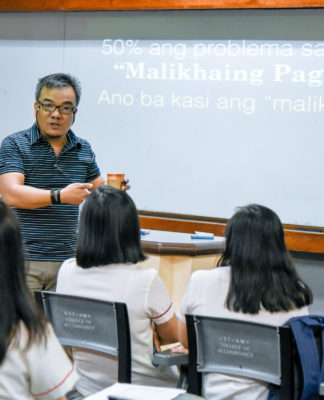UST HAS the rightful claim to the title of Asia’s oldest university, even if it was not the first university to be established in the Philippines, the head of UST’s history department has said.
This also holds true despite a rival claim by Cebu’s University of San Carlos which supposedly originated from the Colegio Seminario de San Ildefonso established in 1595.
Historian Augusto de Viana said Philippine Star columnist Isagani Cruz erred in claiming that the defunct Universidad de San Ignacio, established in Intramuros in 1590, is the oldest university in Asia “based on an institution’s origin to the time it was founded, not to the time it was named a university.”
De Viana pointed to UST’s continuous existence since 1611.
UST became a university by papal edict in 1645, although all Dominican colleges around the world had been given the right to confer university degrees as early as 1619.
“While it is true that the Colegio Seminario de San Ignacio and Colegio Seminario de San Ildefonso both antedated the University of Santo Tomas, both institutions do not anymore exist,” De Viana said.
The two Jesuit institutions were abolished after the expulsion of the Society of Jesus in the country in 1768 through Spanish King Charles III’s decree. In 1783, the San Carlos Seminary was established on the ruins of Colegio Seminario de San Ildefonso. The Vincentian Fathers took over the seminary in 1867. The college, or Colegio de San Carlos, meanwhile, transferred to a new site in 1930 and was turned over to the Society of the Divine Word in 1935. It was given university status by the government in 1948.
It is known today as the University of San Carlos.
De Viana said the University of San Carlos cannot trace its origin from Colegio Seminario de San Ildefonso. “What existed in Cebu were three different institutions,” he said. “[They] are different in nature, and the place is purely accidental.”
De Viana also refuted Cruz’s claim that the Seminary of San Carlos was entrusted to the Dominicans.
“The bishop of Cebu, Msgr. Romualdo Jimeno, always wanted to have a Dominican friar from UST as a secretary who could serve as his counselor,” he said. “Four Dominicans served him in succession, but none of them had any part in the administration of the seminary or became rectors.”
The columnist also noted that the old Universidad de San Ignacio was “incorporated as a mere College of Medicine and Pharmacy” into UST after the Jesuits left the country.
De Viana rebutted: “The colleges of Medicine and Pharmacy were established in 1871, more than a century after the expulsion of the Jesuits in the islands.”
“UST was the first university in Asia to offer degrees in these disciplines,” he added.
De Viana noted that some of Cruz’ arguments in his column were from a Wikipedia article that quoted the UST website.
The website already bears the corrections as of the last viewing of the Varsitarian.
UST website corrected
In his letter to the Varsitarian, De Viana clarified entries about historical markers on the UST website as earlier corrected by historian Jose Victor Torres.
Torres earlier said that the “black bronze plaque” that marked the opening of what was then the new campus building was installed in 1935 by the National Historical Commission headed by Eulogio Rodriguez Sr.
“The first plaque is really a cast iron marker, not a bronze plaque,” De Viana said. “It was installed in 1935 by the Historical Research and Markers Committee, not the National Historical Commission. [The latter] did not come into existence until July 1, 1965.”
The committee’s first head was an American journalist named Walter Robb, he added.
“Eulogio ‘Amang’ Rodriguez never headed the agency. There was however a namesake named Eulogio B. Rodriguez who served as a member of the committee,” De Viana said.
De Viana clarified that the wooden marker said to carry the names of University colleges actually bears the names of “courses” such as Curso de Enfemeria or Nursing, and Diplomacia y Servicio Consular or Diplomacy and Consular Service, among others.
But he agreed with Torres that there were only around 3,700 civilian internees in the UST internment camp during World War II, not 10,000 as earlier stated in the UST website.
Torres, for his part, said De Viana did not debunk anything that he said, but merely “clarified” them. “[He] merely added to the veracity of the facts by correcting errors,” Torres said in an e-mail to theVarsitarian.
However, Torres still spotted another hitch in the corrected website. “It said that [UST] was internment camp for ‘allied civilians,”’ he said. “‘Allied’ is not a mere adjective or verb. It should be a proper noun [since] it refers to the three main Allied nations during World War II –United States, Britain, and France, as well as other nations who joined them against the Axis powers –Germany, Italy, and Japan. Thus, the people confined were ‘Allied civilians.’” Sarah Jane P. Pauyo

















